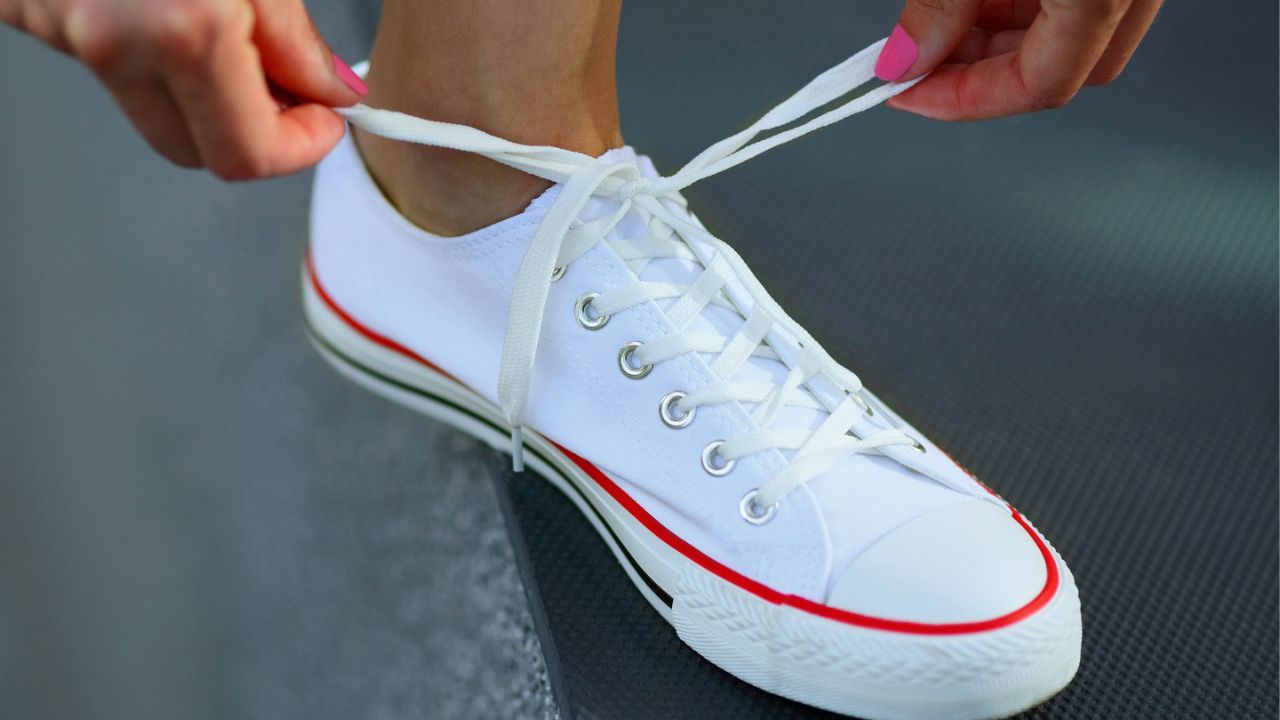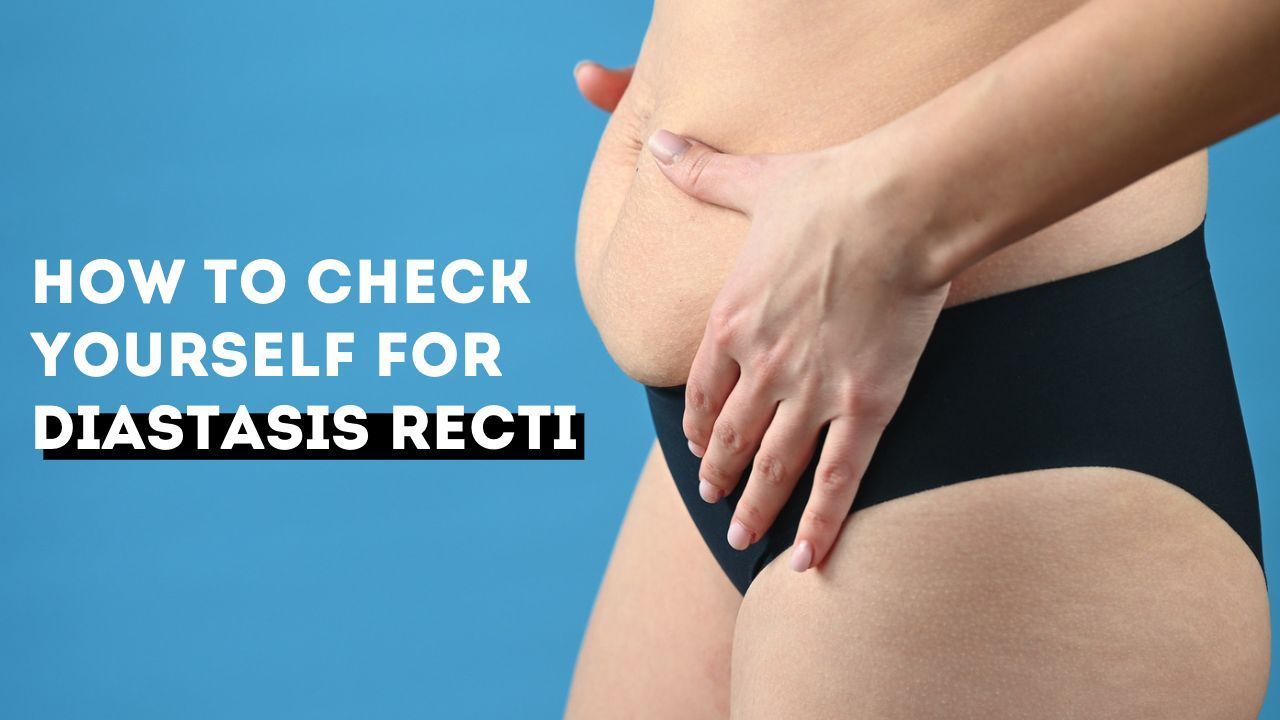What can a SHOE teach us about our core?!

Do you know what a shoe and your core have in common?!
First, a quick anatomy lesson:
- When you do a crunch or a sit-up, you are using your rectus or 6-pack abs. They run vertically up and down the front of your stomach.
- When you do a low pressure ab exercise, you are using your transverse or corset or wraparound abs. They wrap all the way around your waist, even around the back!
Which one of the above do you think resembles pulling your shoelaces tight?
It’s okay. I’ll wait while you ponder on it…

That’s right. It’s number 2. When you tie your shoelaces tight, it makes your shoe tighter. It makes it really nice and snug around your foot. Vs, pulling the tongue of your shoe (your 6 pack abs), which does nothing to make the shoe fit any tighter.
When you train your transverse abs with low pressure core exercises, you are essentially tying your shoelaces tight around your midsection. Making your tummy smaller and smaller, and tighter and tighter. No amount o...
Why sit ups might be damaging your core

Have you ever noticed when you do sit-ups that your stomach turns into a funny shape? That’s because your core is like a pressure canister and instead of the pressure being managed correctly, everything is squishing out in all the wrong places: putting forward pressure on your abs (which will make a diastasis worse), and putting downward pressure on your pelvic floor (making prolapse and leaking worse), and not to mention making your back pain worse.
When I say sit ups, I’m referring to any core exercise where you lift your head and chest off the floor. So sit ups, crunches, the Pilates 100s, series of 5 etc.
If you ever notice weird shapes happening in your stomach like doming (looks like a stomach mohawk), or coning (looks like your abs are sinking), you should immediately back off. If this is happening, you won’t get a stronger core by “just doing more”. You won’t. I can promise you.
What needs to happen first, is that you need to teach your body how to manage this pres...
A tight pelvic floor is a weak pelvic floor!

Have you noticed that we are often told to "squeeze" and "tighten" our pelvic floor muscles in order to improve pelvic floor strength?
🚨Newsflash: A “TIGHT” pelvic floor isn't the same as a “STRONG” one!
Tightness and weakness actually go hand in hand. I always say that they are best buds. So if you haven't had any luck with your usual pelvic floor exercises, then it may be time to reassess a few things.
So what's the difference between “tightness” and “strength”?
For decades, women have been told to "just do Kegels" as a way to "tighten" our pelvic floor. But it's actually not tightness we are looking for. It's STRENGTH. Two VERY different things.
The way Kegels are taught typically encourages pelvic floor "squeezing". Which creates tightness. But when a muscle is too tight, it can't work correctly.
Just like any other muscle in the body, the pelvic floor muscles must be able to lengthen and relax, as well as contract. Isolated tension and tightness are not use...
Is It Really Bloating..?

If you’re experiencing belly bloating and despite endless food eliminations, you just cannot get to the bottom of your mysterious bloating, there’s a really good chance there could be something non food related at play. Hear me out here…
The anatomy of a bulging tummy:
If you’ve ever seen one of those old English Victorian houses where the walls are bowed due to a compromised or damaged foundation, the exact same thing happens in the body when the foundation (pelvic floor) has been weakened.
What that looks like is a bulging in the abdomen area (commonly known as the “mummy tummy” and is often mistaken for food related bloating when in actual fact it’s very often an issue with the pelvic floor (although it absolutely can be both).
It’s definitely not unique to women. If you know someone with a “dad belly” there’s a good chance they’ve neglected their pelvic floor over time too.
The causes of a “mummy tummy”:
Essentially the underlying cause of a “mummy tummy” is usu...
How to stop peeing when you sneeze (or run, or jump, or laugh)

You might be surprised to know that leaking is a surprisingly easy fix.
So quite why we have all been led to believe that’s it’s something that we must now “tolerate” because “we are mums now” is an absolute mystery to me 🤷🏼♀️
There’s a name for it. It’s called Stress Incontinence, and it occurs when you cough, laugh, run, jump, sneeze, etc., and you pee your pants a little as a result. This often happens when too much pressure is exerted on the bladder, forcing urine out. In most cases, this is a result of weakened pelvic floor muscles, usually due to childbirth, age, and/or menopause.
Urge Incontinence occurs when there is a strong urge to urinate despite the fact that your bladder may not be full. This urge is often strong enough that you can’t make it to the bathroom in time. This is usually related to having a pelvic floor that is too tight (often from doing too many “Kegels”). This is a whole separate conversation. But I will just say that tightness does not equal ...
6 Things I Wish Women Were Taught About Their Bodies

I wish I'd been more informed prior to embarking on the journey to motherhood. It’s now my passion to make sure others have all the info they need. Here are some of my latest musings…
1. “Postpartum” doesn’t end after 6 weeks.
The idea that the “postpartum phase” is technically only the first 6 weeks after birth is misguiding, and sets women up for feelings of inadequacy. It’s an unrealistic standard placed on mothers by society. In reality, it very often takes 1-2 years (sometimes more) to recover from 10 months of pregnancy + childbirth
2. There’s no such thing as “bouncing back”.
Let’s stop using the phrase “bounce back” and let’s stop expecting that of our bodies. Instead let’s focus on bouncing FORWARD, embracing and celebrating all that we’ve become, and working to become the strongest, most capable versions of our NEW selves.
3. Peeing your pants when you run, jump or sneeze is extremely common, but it’s NOT normal.
Women have been led to believe that this is some...
5 Daily Movements to Avoid With Diastasis

(and what to do instead...)
Don’t let these common movements hold you back from healing your diastasis. These movements will actually make it worse. So if you’ve been working hard to fix it, make sure your efforts aren’t in vain by making sure you make these small lifestyle adjustments as well.
Here are 5 daily movements to avoid and what to do instead:
1. Sneezing without engaging your core

Sneezing, coughing and blowing your nose exerts forceful pressure on your abdominal muscles, causing them to bulge forward, putting stress on the already compromised connective tissue. This connective tissue (the linea alba) is what holds your abdominal muscles together, and is one of the slowest tissues in the body to repair. If we are working to repair, but also regularly putting pressure on it, we are taking one step forward, two steps back.
2. Sitting straight up from laying down

Have you ever sat up in bed, or gone to get up from your matwork and noticed your abs domin...
Most people think that diastasis looks like this…

When you think about Diastasis Recti (DR), most people think that it either can’t be seen from the outside, that it can only be detected if you try to put your fingers in between your abs, or that if you can see it from the outside that it would look like the first picture above.
But there are actually some pretty common tell tale signs just from looking at a person's stomach (even with clothes on) that they might have a DR.
The thing with diastasis recti is that the two “six pack” muscles are no longer being held tightly together by connective tissue, causing essentially a “collapse” of the abdominal wall and causing it to fall forward. If the muscles are still loose, the connective tissue has nothing firm to hold onto. And if the connective tissue has nothing firm to hold onto and is therefore still loose, then the skin has nothing firm to hold onto either. A domino effect. Because of this, a very common tell tale sign that there might be a DR present, is a sagging belly. Esp...
How to check yourself for Diastasis Recti

I hear so many women confused about whether or not they have ab separation, so let's dive in. Hopefully this information will be helpful to you.
Diastasis recti (or abdominal separation) happens when the connective tissue between your two rectus abdominis muscles or “six-pack” abs become stretched beyond their usual capacity and move apart to allow more space. During pregnancy, the six-pack muscles stretch to TWICE their original length! In some women it resolves by itself after pregnancy, but for the majority of us (especially those of us over 30), it often requires a bit of help to bring the muscles back together again. But contrary to common opinion, diastasis recti (DR) is not unique to pregnant women. It can also be caused by weight gain, weightlifting without proper abdominal pressure management, and is also more common than you would think in men!
As a result of this muscle separation, you might notice (or feel) a gap down the midline of your belly that you can fit your ...
How to lose inches off your waist without dieting

You will never hear me preaching about weight loss, or dieting, or “bouncing back”. Those aren’t phrases I ever use because I’m passionate about teaching women that when we focus instead on teaching the body how to FUNCTION at its absolute best, we will feel so much more capable, aligned, alive. The rest will fall into place.
Stay with me here, because I know you’re thinking “skinny bitch. What does she know? How can she possibly help me?” Hear me out because I have a track record for helping other women lose multiple inches off their waistline, because despite what many women think, those extra inches are not always “weight” related.
While bloating can very often be food related, as a pelvic floor expert I see all too often that a weak pelvic floor also has a huge effect on the way our midsection looks and very often is a major contributor to “belly bulge”. The pelvic floor is the literal foundation of your core, and if you’ve been doing all the crunches with a weak pelvic fl...

